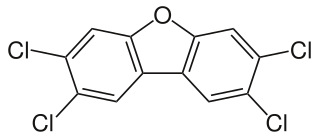| number | formula | name | CAS Number | InChIKey |
|---|
| PCDF-1 |  | 1-chlorodibenzofuran | 84761-86-4 | WRSMJZYBNIAAEE-UHFFFAOYSA-N |
| PCDF-2 |  | 2-chlorodibenzofuran | 51230-49-0 | PRKTYWJFCODJOA-UHFFFAOYSA-N |
| PCDF-3 |  | 3-chlorodibenzofuran | 25074-67-3 | BBOZMMAURMEVAR-UHFFFAOYSA-N |
| PCDF-4 |  | 4-chlorodibenzofuran | 74992-96-4 | RHRYBWFAHXCUCR-UHFFFAOYSA-N |
| PCDF-12 |  | 1,2-dichlorodibenzofuran | 64126-85-8 | QVAPRJWSOUITIF-UHFFFAOYSA-N |
| PCDF-13 |  | 1,3-dichlorodibenzofuran | 94538-00-8 | VKIBKEFGJSPRJC-UHFFFAOYSA-N |
| PCDF-14 |  | 1,4-dichlorodibenzofuran | 94538-01-9 | VHQCMZLPHWGUDB-UHFFFAOYSA-N |
| PCDF-16 |  | 1,6-dichlorodibenzofuran | 74992-97-5 | JRSRWACZUFLWKF-UHFFFAOYSA-N |
| PCDF-17 |  | 1,7-dichlorodibenzofuran | 94538-02-0 | XRQNHPGZRFKBJW-UHFFFAOYSA-N |
| PCDF-18 |  | 1,8-dichlorodibenzofuran | 81638-37-1 | UAFNQQBPUWFPGC-UHFFFAOYSA-N |
| PCDF-19 |  | 1,9-dichlorodibenzofuran | 70648-14-5 | AEKSGHBVWJHELW-UHFFFAOYSA-N |
| PCDF-23 |  | 2,3-dichlorodibenzofuran | 64126-86-9 | GETJJZZRPQFSFM-UHFFFAOYSA-N |
| PCDF-24 |  | 2,4-dichlorodibenzofuran | 24478-74-8 | LHTCKMYRNOGUOA-UHFFFAOYSA-N |
| PCDF-26 |  | 2,6-dichlorodibenzofuran | 60390-27-4 | XVLCNKFGFHUQNL-UHFFFAOYSA-N |
| PCDF-27 |  | 2,7-dichlorodibenzofuran | 74992-98-6 | DOZUTNBCPVUMPY-UHFFFAOYSA-N |
| PCDF-28 |  | 2,8-dichlorodibenzofuran | 5409-83-6 | IVVRJIDVYSPKFZ-UHFFFAOYSA-N |
| PCDF-34 |  | 3,4-dichlorodibenzofuran | 94570-83-9 | HYQGGNWDPQZLGX-UHFFFAOYSA-N |
| PCDF-36 |  | 3,6-dichlorodibenzofuran | 74918-40-4 | DMOBGFAKTSXOHG-UHFFFAOYSA-N |
| PCDF-37 |  | 3,7-dichlorodibenzofuran | 58802-21-4 | OLTYAGNRSNFHLK-UHFFFAOYSA-N |
| PCDF-46 |  | 4,6-dichlorodibenzofuran | 64560-13-0 | BZFIZJNKNCJEAD-UHFFFAOYSA-N |
| PCDF-123 |  | 1,2,3-trichlorodibenzofuran | 83636-47-9 | LADSWAAWPMGHBE-UHFFFAOYSA-N |
| PCDF-124 |  | 1,2,4-trichlorodibenzofuran | 24478-73-7 | RQIWKWHVZLDXEJ-UHFFFAOYSA-N |
| PCDF-126 |  | 1,2,6-trichlorodibenzofuran | 64560-15-2 | CYRZCBUWRUACKJ-UHFFFAOYSA-N |
| PCDF-127 |  | 1,2,7-trichlorodibenzofuran | 83704-37-4 | AFOVQGPNOZDUEP-UHFFFAOYSA-N |
| PCDF-128 |  | 1,2,8-trichlorodibenzofuran | 83704-34-1 | UYIGPSPCOXGBCS-UHFFFAOYSA-N |
| PCDF-129 |  | 1,2,9-trichlorodibenzofuran | 83704-38-5 | ICTXINQOXPMQPM-UHFFFAOYSA-N |
| PCDF-134 |  | 1,3,4-trichlorodibenzofuran | 82911-61-3 | FIPOITUDJFQRRN-UHFFFAOYSA-N |
| PCDF-136 |  | 1,3,6-trichlorodibenzofuran | 83704-39-6 | AGPTXRLVBIRYLV-UHFFFAOYSA-N |
| PCDF-137 |  | 1,3,7-trichlorodibenzofuran | 64560-16-3 | INRBXOGZPDFCLQ-UHFFFAOYSA-N |
| PCDF-138 |  | 1,3,8-trichlorodibenzofuran | 76621-12-0 | PHFSTDOPTZHECA-UHFFFAOYSA-N |
| PCDF-139 |  | 1,3,9-trichlorodibenzofuran | 83704-40-9 | SPPGDLROKBFNNO-UHFFFAOYSA-N |
| PCDF-146 |  | 1,4,6-trichlorodibenzofuran | 82911-60-2 | XDQRWSUJOURTHK-UHFFFAOYSA-N |
| PCDF-147 |  | 1,4,7-trichlorodibenzofuran | 83704-41-0 | XTLMVJUSIANHND-UHFFFAOYSA-N |
| PCDF-148 |  | 1,4,8-trichlorodibenzofuran | 64560-14-1 | PCQCYDNFBUADOK-UHFFFAOYSA-N |
| PCDF-149 |  | 1,4,9-trichlorodibenzofuran | 70648-13-4 | NVYUPBVXKLTYHV-UHFFFAOYSA-N |
| PCDF-167 (PCDF-349) |  | 1,6,7-trichlorodibenzofuran | 83704-46-5 | HEWLCNCSWBMZHG-UHFFFAOYSA-N |
| PCDF-168 (PCDF-249) |  | 1,6,8-trichlorodibenzofuran | 82911-59-9 | ZOBVYDQWZXUJNO-UHFFFAOYSA-N |
| PCDF-178 (PCDF-239) |  | 1,7,8-trichlorodibenzofuran | 58802-18-9 | YNMCXGLWHTVMQO-UHFFFAOYSA-N |
| PCDF-234 |  | 2,3,4-trichlorodibenzofuran | 57117-34-7 | YDLADWPBKZODCJ-UHFFFAOYSA-N |
| PCDF-236 |  | 2,3,6-trichlorodibenzofuran | 57117-33-6 | CPMGJTLNRBIKQM-UHFFFAOYSA-N |
| PCDF-237 |  | 2,3,7-trichlorodibenzofuran | 58802-17-8 | CKXMNTLGGAOERF-UHFFFAOYSA-N |
| PCDF-238 |  | 2,3,8-trichlorodibenzofuran | 57117-32-5 | NUNSNNOYACKRIK-UHFFFAOYSA-N |
| PCDF-246 |  | 2,4,6-trichlorodibenzofuran | 58802-14-5 | GTKURBTWZFQHHY-UHFFFAOYSA-N |
| PCDF-247 |  | 2,4,7-trichlorodibenzofuran | 83704-42-1 | SZBZRVJHPZIGAY-UHFFFAOYSA-N |
| PCDF-248 |  | 2,4,8-trichlorodibenzofuran | 54589-71-8 | WJURXKWTCOMRCE-UHFFFAOYSA-N |
| PCDF-346 |  | 3,4,6-trichlorodibenzofuran | 83704-43-2 | XEUHBCMRIXEBTD-UHFFFAOYSA-N |
| PCDF-347 |  | 3,4,7-trichlorodibenzofuran | 83704-44-3 | RPJJBTSXPNFUTA-UHFFFAOYSA-N |
| PCDF-348 |  | 3,4,8-trichlorodibenzofuran | 83704-45-4 | YTZWNIQGGIJHJX-UHFFFAOYSA-N |
| PCDF-1234 |  | 1,2,3,4-tetrachlorodibenzofuran | 24478-72-6 | AETAPIFVELRIDN-UHFFFAOYSA-N |
| PCDF-1236 |  | 1,2,3,6-tetrachlorodibenzofuran | 83704-21-6 | BBAXFLIBRPXRBP-UHFFFAOYSA-N |
| PCDF-1237 |  | 1,2,3,7-tetrachlorodibenzofuran | 83704-22-7 | MDNZFYGATDCKRB-UHFFFAOYSA-N |
| PCDF-1238 |  | 1,2,3,8-tetrachlorodibenzofuran | 62615-08-1 | KFQRHGKKSHJMCO-UHFFFAOYSA-N |
| PCDF-1239 |  | 1,2,3,9-tetrachlorodibenzofuran | 83704-23-8 | GNQHLJHTOATTOJ-UHFFFAOYSA-N |
| PCDF-1246 |  | 1,2,4,6-tetrachlorodibenzofuran | 71998-73-7 | NLVWEKPJFUPVMZ-UHFFFAOYSA-N |
| PCDF-1247 |  | 1,2,4,7-tetrachlorodibenzofuran | 83719-40-8 | MFURKMJLDQBHRA-UHFFFAOYSA-N |
| PCDF-1248 |  | 1,2,4,8-tetrachlorodibenzofuran | 64126-87-0 | BFTASCFRRBHFFK-UHFFFAOYSA-N |
| PCDF-1249 |  | 1,2,4,9-tetrachlorodibenzofuran | 83704-24-9 | ZUYYTCCHKQGGOV-UHFFFAOYSA-N |
| PCDF-1267 |  | 1,2,6,7-tetrachlorodibenzofuran | 83704-25-0 | AUEWYHHKDYUYMI-UHFFFAOYSA-N |
| PCDF-1268 |  | 1,2,6,8-tetrachlorodibenzofuran | 83710-07-0 | KCVGVSIBBGIJNZ-UHFFFAOYSA-N |
| PCDF-1269 |  | 1,2,6,9-tetrachlorodibenzofuran | 70648-18-9 | IEPGLLVEBKXASE-UHFFFAOYSA-N |
| PCDF-1278 |  | 1,2,7,8-tetrachlorodibenzofuran | 58802-20-3 | JODWPAQNABOHDG-UHFFFAOYSA-N |
| PCDF-1279 |  | 1,2,7,9-tetrachlorodibenzofuran | 83704-26-1 | PDMFRPIFZAKMLH-UHFFFAOYSA-N |
| PCDF-1289 |  | 1,2,8,9-tetrachlorodibenzofuran | 70648-22-5 | OHYCQUKMNPHFPT-UHFFFAOYSA-N |
| PCDF-1346 |  | 1,3,4,6-tetrachlorodibenzofuran | 83704-27-2 | CBBDONKZEJKFJP-UHFFFAOYSA-N |
| PCDF-1347 |  | 1,3,4,7-tetrachlorodibenzofuran | 70648-16-7 | UMKCVDZTSZNWRH-UHFFFAOYSA-N |
| PCDF-1348 |  | 1,3,4,8-tetrachlorodibenzofuran | 92341-04-3 | XWKRJSMNDOXIHS-UHFFFAOYSA-N |
| PCDF-1349 |  | 1,3,4,9-tetrachlorodibenzofuran | 83704-28-3 | PNCYJHOTZSKZPA-UHFFFAOYSA-N |
| PCDF-1367 |  | 1,3,6,7-tetrachlorodibenzofuran | 57117-36-9 | PITDPGCTIMCYEZ-UHFFFAOYSA-N |
| PCDF-1368 |  | 1,3,6,8-tetrachlorodibenzofuran | 71998-72-6 | BDXKVABZWRZKOS-UHFFFAOYSA-N |
| PCDF-1369 |  | 1,3,6,9-tetrachlorodibenzofuran | 83690-98-6 | NJQQZRLWVLWNGD-UHFFFAOYSA-N |
| PCDF-1378 |  | 1,3,7,8-tetrachlorodibenzofuran | 57117-35-8 | CSXDVUGDFSYXTD-UHFFFAOYSA-N |
| PCDF-1379 |  | 1,3,7,9-tetrachlorodibenzofuran | 64560-17-4 | IEMJMCVYAORWJV-UHFFFAOYSA-N |
| PCDF-1467 |  | 1,4,6,7-tetrachlorodibenzofuran | 66794-59-0 | RBFNYMHNIOKXLA-UHFFFAOYSA-N |
| PCDF-1468 |  | 1,4,6,8-tetrachlorodibenzofuran | 82911-58-8 | VHOBVPNETFRJED-UHFFFAOYSA-N |
| PCDF-1469 |  | 1,4,6,9-tetrachlorodibenzofuran | 70648-19-0 | JAYSBJFHDJOMGZ-UHFFFAOYSA-N |
| PCDF-1478 |  | 1,4,7,8-tetrachlorodibenzofuran | 83704-29-4 | IVRDRRWQABCXLY-UHFFFAOYSA-N |
| PCDF-1678 |  | 1,6,7,8-tetrachlorodibenzofuran | 83704-33-0 | KOJMOXYETDLOPN-UHFFFAOYSA-N |
| PCDF-2346 |  | 2,3,4,6-tetrachlorodibenzofuran | 83704-30-7 | JNVHSHPAAMRSKK-UHFFFAOYSA-N |
| PCDF-2347 |  | 2,3,4,7-tetrachlorodibenzofuran | 83704-31-8 | BROFYOSLFHTGCQ-UHFFFAOYSA-N |
| PCDF-2348 |  | 2,3,4,8-tetrachlorodibenzofuran | 83704-32-9 | IIKXRERKNIJJQY-UHFFFAOYSA-N |
| PCDF-2367 |  | 2,3,6,7-tetrachlorodibenzofuran | 57117-39-2 | MJCNKMDTLRSHNK-UHFFFAOYSA-N |
| PCDF-2368 |  | 2,3,6,8-tetrachlorodibenzofuran | 57117-37-0 | SPMZHWVRMWWTSY-UHFFFAOYSA-N |
| PCDF-2378 |  | 2,3,7,8-tetrachlorodibenzofuran | 51207-31-9 | KSMVNVHUTQZITP-UHFFFAOYSA-N |
| PCDF-2467 |  | 2,4,6,7-tetrachlorodibenzofuran | 57117-38-1 | NSDXKMRVQOSASS-UHFFFAOYSA-N |
| PCDF-2468 |  | 2,4,6,8-tetrachlorodibenzofuran | 58802-19-0 | ZSPJEACWUWSAGS-UHFFFAOYSA-N |
| PCDF-3467 |  | 3,4,6,7-tetrachlorodibenzofuran | 57117-40-5 | LMJLCLBSUNZLNW-UHFFFAOYSA-N |
| PCDF-12346 |  | 1,2,3,4,6-pentachlorodibenzofuran | 83704-47-6 | LIQJBAPSLUZUTB-UHFFFAOYSA-N |
| PCDF-12347 |  | 1,2,3,4,7-pentachlorodibenzofuran | 83704-48-7 | DOJZTBGOWIYFAC-UHFFFAOYSA-N |
| PCDF-12348 |  | 1,2,3,4,8-pentachlorodibenzofuran | 67517-48-0 | ZCTNDJSCLPJCRA-UHFFFAOYSA-N |
| PCDF-12349 |  | 1,2,3,4,9-pentachlorodibenzofuran | 83704-49-8 | IQSZNZVZXOFRJS-UHFFFAOYSA-N |
| PCDF-12367 |  | 1,2,3,6,7-pentachlorodibenzofuran | 57117-42-7 | NZUPQBVDIWCPBX-UHFFFAOYSA-N |
| PCDF-12368 |  | 1,2,3,6,8-pentachlorodibenzofuran | 83704-51-2 | VHQJZOFUPXEZQZ-UHFFFAOYSA-N |
| PCDF-12369 |  | 1,2,3,6,9-pentachlorodibenzofuran | 83704-52-3 | IPSFQAKXDJVQOX-UHFFFAOYSA-N |
| PCDF-12378 |  | 1,2,3,7,8-pentachlorodibenzofuran | 57117-41-6 | SBMIVUVRFPGOEB-UHFFFAOYSA-N |
| PCDF-12379 |  | 1,2,3,7,9-pentachlorodibenzofuran | 83704-53-4 | JVUSEQPOWCBYNG-UHFFFAOYSA-N |
| PCDF-12389 |  | 1,2,3,8,9-pentachlorodibenzofuran | 83704-54-5 | NKGLWUJPCTUDEH-UHFFFAOYSA-N |
| PCDF-12467 |  | 1,2,4,6,7-pentachlorodibenzofuran | 83704-50-1 | BQTCODOVGXJHRB-UHFFFAOYSA-N |
| PCDF-12468 |  | 1,2,4,6,8-pentachlorodibenzofuran | 69698-57-3 | JDTUAYPJSSXDNO-UHFFFAOYSA-N |
| PCDF-12469 |  | 1,2,4,6,9-pentachlorodibenzofuran | 70648-24-7 | QDQFGVXGPSYEJU-UHFFFAOYSA-N |
| PCDF-12478 |  | 1,2,4,7,8-pentachlorodibenzofuran | 58802-15-6 | GCFDWHIKRXCUPJ-UHFFFAOYSA-N |
| PCDF-12479 |  | 1,2,4,7,9-pentachlorodibenzofuran | 71998-74-8 | IYGVHNHWORPMFU-UHFFFAOYSA-N |
| PCDF-12489 |  | 1,2,4,8,9-pentachlorodibenzofuran | 70648-23-6 | ZSPAPWGNAGTCCA-UHFFFAOYSA-N |
| PCDF-12678 (PCDF-23489) |  | 1,2,6,7,8-pentachlorodibenzofuran | 69433-00-7 | ZAAVDGLJEOXCMV-UHFFFAOYSA-N |
| PCDF-12679 |  | 1,2,6,7,9-pentachlorodibenzofuran | 70872-82-1 | QQRRQEVOSMEVQB-UHFFFAOYSA-N |
| PCDF-13467 |  | 1,3,4,6,7-pentachlorodibenzofuran | 83704-36-3 | JVYYDUWJIJMOGW-UHFFFAOYSA-N |
| PCDF-13468 |  | 1,3,4,6,8-pentachlorodibenzofuran | 83704-55-6 | COKIAYPRHYHYCH-UHFFFAOYSA-N |
| PCDF-13469 |  | 1,3,4,6,9-pentachlorodibenzofuran | 70648-15-6 | MYSAFUYQSBEEDR-UHFFFAOYSA-N |
| PCDF-13478 |  | 1,3,4,7,8-pentachlorodibenzofuran | 58802-16-7 | ORSUQGVCWLXKLZ-UHFFFAOYSA-N |
| PCDF-13479 |  | 1,3,4,7,9-pentachlorodibenzofuran | 70648-20-3 | GFXPLABVZOBCCW-UHFFFAOYSA-N |
| PCDF-13678 |  | 1,3,6,7,8-pentachlorodibenzofuran | 70648-21-4 | FRLMQDUYUJIHCZ-UHFFFAOYSA-N |
| PCDF-14678 |  | 1,4,6,7,8-pentachlorodibenzofuran | 83704-35-2 | VANGHZRYKXDPRR-UHFFFAOYSA-N |
| PCDF-23467 |  | 2,3,4,6,7-pentachlorodibenzofuran | 57117-43-8 | SJFBZRQKGOGHEV-UHFFFAOYSA-N |
| PCDF-23468 |  | 2,3,4,6,8-pentachlorodibenzofuran | 67481-22-5 | MKRFORPSRBMAIP-UHFFFAOYSA-N |
| PCDF-23478 |  | 2,3,4,7,8-pentachlorodibenzofuran | 57117-31-4 | OGBQILNBLMPPDP-UHFFFAOYSA-N |
| PCDF-123467 |  | 1,2,3,4,6,7-hexachlorodibenzofuran | 79060-60-9 | SNWFMKXFMVHBKD-UHFFFAOYSA-N |
| PCDF-123468 |  | 1,2,3,4,6,8-hexachlorodibenzofuran | 69698-60-8 | UCFGNWHERVQWMZ-UHFFFAOYSA-N |
| PCDF-123469 |  | 1,2,3,4,6,9-hexachlorodibenzofuran | 91538-83-9 | KFFUZIROJGXTQH-UHFFFAOYSA-N |
| PCDF-123478 |  | 1,2,3,4,7,8-hexachlorodibenzofuran | 70648-26-9 | LVYBAQIVPKCOEE-UHFFFAOYSA-N |
| PCDF-123479 |  | 1,2,3,4,7,9-hexachlorodibenzofuran | 91538-84-0 | BKIXWRBZCQEZAQ-UHFFFAOYSA-N |
| PCDF-123489 |  | 1,2,3,4,8,9-hexachlorodibenzofuran | 92341-07-6 | VSDUQUBUJRNREH-UHFFFAOYSA-N |
| PCDF-123678 |  | 1,2,3,6,7,8-hexachlorodibenzofuran | 57117-44-9 | JEYJJJXOFWNEHN-UHFFFAOYSA-N |
| PCDF-123679 |  | 1,2,3,6,7,9-hexachlorodibenzofuran | 92341-06-5 | JZVOLXQREJNTTL-UHFFFAOYSA-N |
| PCDF-123689 |  | 1,2,3,6,8,9-hexachlorodibenzofuran | 75198-38-8 | WLGQZUOHEXTWFH-UHFFFAOYSA-N |
| PCDF-123789 |  | 1,2,3,7,8,9-hexachlorodibenzofuran | 72918-21-9 | PYUSJFJVDVSXIU-UHFFFAOYSA-N |
| PCDF-124678 |  | 1,2,4,6,7,8-hexachlorodibenzofuran | 67562-40-7 | CKDDYGBBKXIHRY-UHFFFAOYSA-N |
| PCDF-124679 |  | 1,2,4,6,7,9-hexachlorodibenzofuran | 75627-02-0 | FAHIPPHRJJJQOG-UHFFFAOYSA-N |
| PCDF-124689 |  | 1,2,4,6,8,9-hexachlorodibenzofuran | 69698-59-5 | FGZCXIPKUCJGHW-UHFFFAOYSA-N |
| PCDF-134678 |  | 1,3,4,6,7,8-hexachlorodibenzofuran | 71998-75-9 | OGTZINCGZYXZCR-UHFFFAOYSA-N |
| PCDF-134679 |  | 1,3,4,6,7,9-hexachlorodibenzofuran | 92341-05-4 | TURXXOIFVABBPW-UHFFFAOYSA-N |
| PCDF-234678 |  | 2,3,4,6,7,8-hexachlorodibenzofuran | 60851-34-5 | XTAHLACQOVXINQ-UHFFFAOYSA-N |
| PCDF-1234678 |  | 1,2,3,4,6,7,8-heptachlorodibenzofuran | 67562-39-4 | WDMKCPIVJOGHBF-UHFFFAOYSA-N |
| PCDF-1234679 |  | 1,2,3,4,6,7,9-heptachlorodibenzofuran | 70648-25-8 | JWXWOEUKHXOUSK-UHFFFAOYSA-N |
| PCDF-1234689 |  | 1,2,3,4,6,8,9-heptachlorodibenzofuran | 69698-58-4 | BADFHCOLISGRRW-UHFFFAOYSA-N |
| PCDF-1234789 |  | 1,2,3,4,7,8,9-heptachlorodibenzofuran | 55673-89-7 | VEZCTZWLJYWARH-UHFFFAOYSA-N |
| PCDF-12346789 |  | octachlorodibenzofuran | 39001-02-0 | RHIROFAGUQOFLU-UHFFFAOYSA-N |






















